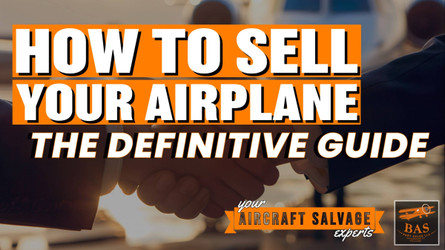How To Sell Your Airplane
Posted by Clinton McJenkin on Dec 12th 2024
The aviation market is booming, with a consistently high demand for aircraft. This presents an excellent opportunity for those looking to sell their planes, but navigating this process effectively requires a strategic approach. This comprehensive guide will walk you through every step, from preparing your paperwork to securing the final payment, ensuring a smooth and successful transaction.


Essential Pre-Sale Preparations

Before even considering advertising your aircraft, ensure your documentation is meticulously organized. This is critical for transparency and building trust with potential buyers.
Document To Perfection
Missing or incomplete paperwork can significantly delay or even derail a sale. If records are missing, the FAA website is a valuable resource. Always prioritize having physical copies for both your records and to provide to buyers.
Determine Fair Market Value
Determining the fair market value of your aircraft is crucial for setting the right price. Several factors influence value:
Aircraft Specifications
This includes the make, model, year, engine type and hours, avionics, and any unique features or modifications.
Condition
The overall condition, including the airframe, paint, interior, and avionics, significantly impacts the value. Regular maintenance and recent upgrades will positively affect the value. Conversely, any unique customizations (like personalized paint jobs or interior modifications) that aren't widely appealing might lessen value.
Be fair when evaluating the condition of the aircraft. We know you love it, but that doesn't add tangible value. Be honest, thorough, and objective when documenting the condition; you will eliminate obstacles to closing the sale quickly.
Market Research
Choosing Your Sales Approach

Selling with a Broker
Utilizing a reputable aircraft broker offers significant advantages:
Market Expertise:
Brokers have deep market knowledge, access to a wider range of potential buyers, and specialized pricing strategies.
Negotiation Skills:
Brokers skillfully navigate the complexities of negotiations, often securing a higher sale price than you could independently.
Marketing and Advertising:
They handle advertising, manage inquiries, and facilitate communication between you and buyers.
However, brokers take a commission from the sale, affecting your final profit. And, as with any professional service, there are good brokers and bad brokers. Always examine the contract terms carefully to clarify fees, payment schedules, and the scope of work and responsibilities of the broker. The more informed you are about what you are getting for those brokerage fees, the better prepared you are to decide if an airplane broker is the right option for you.
Selling Yourself
If you’re comfortable managing all the aspects yourself, a direct sale can result in greater profit:
Advertising:
Utilize multiple avenues: online aircraft marketplaces (Controller.com, Trade-A-Plane.com, Barnstormers.com), social media groups (Facebook groups focused on aviation), and potentially local newspapers or bulletin boards. High-quality photos and clear, detailed descriptions are essential.
Buyer Qualification:
Thoroughly vet potential buyers. Verify their pilot credentials (through the FAA database) and financial capabilities. Request proof of funds (bank statements, financial verification) to filter out serious buyers from those who lack the necessary resources.
Negotiation:
Develop strong negotiation tactics. Never reveal your minimum acceptable price; let buyers make the initial offers.
Be prepared to invest significant time and effort into marketing, managing inquiries, handling negotiations, and managing the entire sales process.
Securing the Sale
Regardless of whether you use a broker or sell independently, the closing process requires careful attention:

Contractual Agreements
Always use a legally binding purchase agreement to protect both parties. These agreements should define all terms, conditions, payment schedules, and responsibilities. The Aircraft Owners and Pilots Association (AOPA) offers a useful template. Read the AOPA's details about selling your aircraft and get access to some great templates - click here
Escrow Services
Title Searches
Payment Procedures
Avoid cash transactions. Wire transfers directly to your bank account offer the most security and transparency. Checks are an acceptable alternative, but ensure funds are verified before releasing the aircraft. Discuss the nature and security of these money transfers with your bank so you know what to look for when the transaction is truly complete versus in transfer limbo and vulnerable to something going wrong.
Aircraft Delivery
Fraud Prevention
By diligently following this guide and taking the necessary precautions, you can successfully navigate the process of selling your airplane, whether you choose to work with a broker or handle it independently. Remember, careful preparation, clear communication, and thorough due diligence are essential ingredients for a positive outcome.
Frequently Asked Questions (FAQs)
Do I need a license to buy an airplane?
Do airplanes have titles?
How long does the registration last?
How does the aircraft transfer work?
What is the best recourse if the payment defaults?
Forms for Buying & Selling Your Airplane
Tips for a Quick & Easy Airplane Sale
#1 - Get The Airplane's Records In Order
Bonus Tip
#2 - Document Visually - Take GREAT Pictures
Bonus Tip
Then use a cloud file storage service like Google Drive, iCloud, or DropBox to store the images. These online file storage services make it simple to share a single link to all of the full-resolution images via text or email and they work great from your smart phone. Most are even free!
#3 - Detail The Equipment
#4 - Objectively Describe the Condition
#5 - Be Realistic on Price
#6 - Market Your Airplane Well
#7 - Respond Quickly
#8 - Be Prepared to Negotiate
#9 - Use Escrow
#10 - Be Particular About The Paperwork




